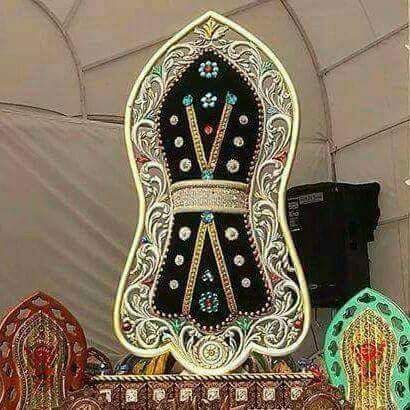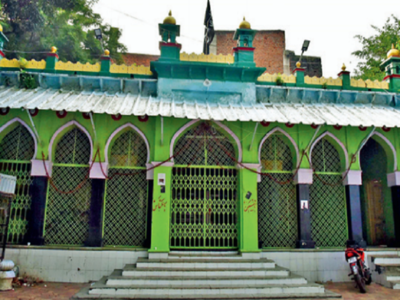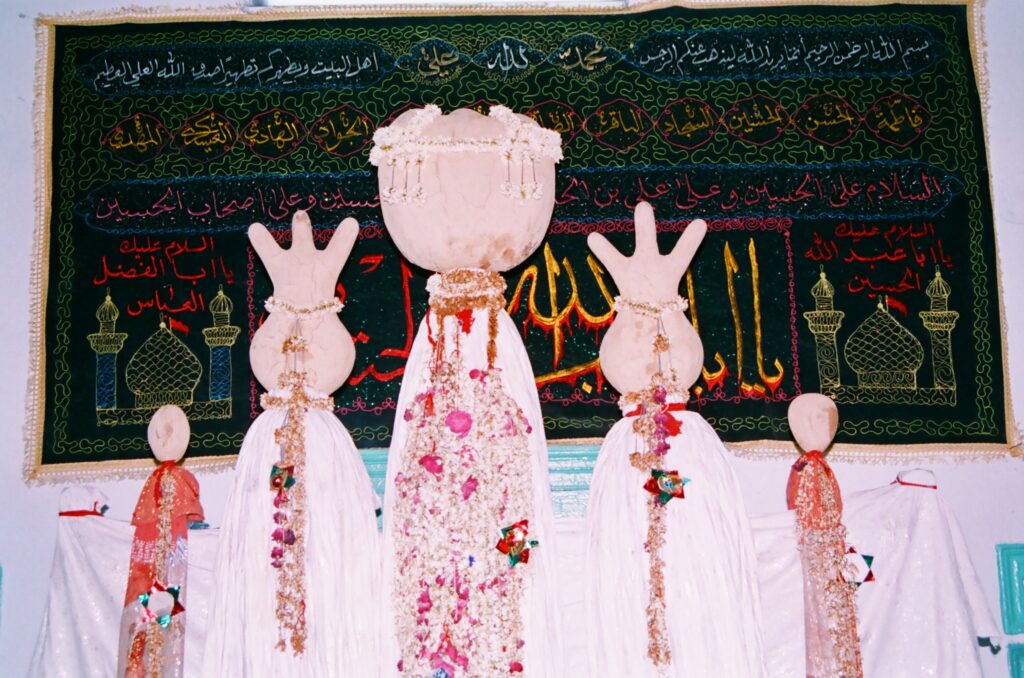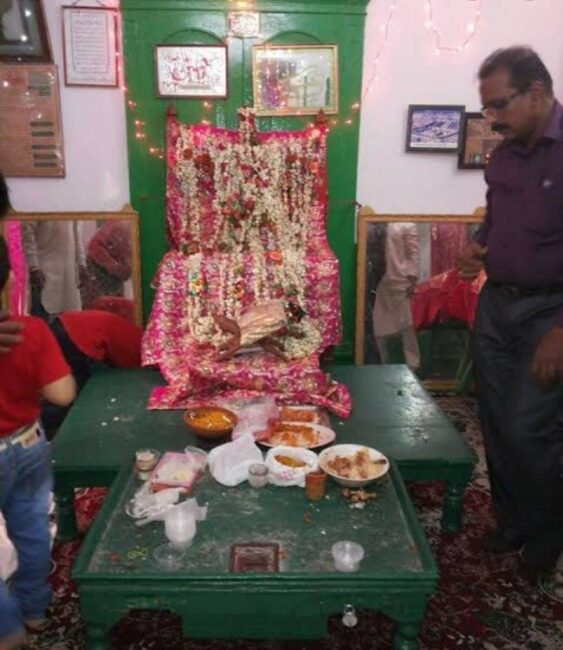N’aal is an Arabic word which means a metallic piece which covers the nose and forehead of a soldier. It is attached to Khud, the armour cap.
The Shia Muslim community’s “Naal-e-Mubarak was brought during the Qutub Shahi rule by an Iranian cleric, Ali Shah. This was covered with sandal and installed as a standard. The Alam is kept open for public from 1st to 10th of Moharrum at Naal Sahib in Pathergatti area in Hyderabad. The standard comes out in the night of 9th Moharrum.

The Naal of Hazrat Imam Hussain was broken during the battle of Karbala. Passing through several hands, it came to Bijapur during the reign of Yusuf Adil Shah, it was sent from Bijapur, to Golconda, along with the Asnads (Certificates) to Ibrahim Qutub Shah. Before the Hyderabad city came into existence the Naal was kept in the shape of Arabic Allah as a part of an Alam and it used to be covered with sandal paste and installed in Golconda. As mentioned in the Gulzar-e-Asafia , after construction of the city of Hyderabad, the Naal Mubarak was shifted to a portion of the Royal Palace known as Ilahi Mahal near Char Kaman. This is the current location where the Alam is installed every year.
The Naal Mubarak is a land-mark of the Moharrum observance in Hyderabad, It is installed on the first of Moharrum with great devotion and comes out in a procession after mid-night of 9-10 Moharrum. The hereditary carrier of the Alam wraps a white cotton sheet of about 6 to 8 metres around his waist. The Alambardars will be bearing the Alam with manifest dignity. The Doribardars carry the rope around the Alam as if they are the retainers of a king circumambulating around the monarch in his progress along the route of the procession. A little behind the Alam will be the Chatarbardars carrying the umbrella. No sooner the Alam emerges from the Alawa the musicians play their pipes and drums.
The roads through which the Alam procession passes attract thousands of devotees who present Nazar irrespective of their religion, caste, or creed.
Utter neglect has taken a heavy toll on the building that houses the historic Naal-e-Mubarak Alam (processional standard) at Pathergatti in the Old City. The old building that has heritage and historical value has turned weak for want of maintenance for a long period.
Mortar chunks fall from the roof at frequent intervals, exposing the sacred alams preserved in the Ashoorkhana. The Naal-e-Mubarak Ashoorkhana does not require more than 2.20 lakh for strengthening its roof and making it water proof. But the Telangana state waqf board has been sitting on the proposal to reinforce the historic structure by sanctioning a few lakhs.
Mir Shabbir Hasan Razvi, Muzavar and Alambardar of Naal-e-Mubarak, sent the proposal with financial estimates to waqf board chairman Mohammad Saleem two years ago. A portion of the roof fell down following rains last week.
The Alam at the Naal-e-Mubarak Ashoorkhana contains a portion of the war helmet (Naal) of Hazrat Imam Hussain. The Alam is about 470 years old. It was first kept in the Golconda fort and when Hyderabad was formed 426 years ago, the Naal-e-Mubarak was shifted to the new city and installed. The Alam is covered with sandal.

“Naal-e-Mubarak was brought during the Qutub Shahi rule by an Iranian cleric, Ali Shah. This was covered with sandal and installed as a standard. The Alam is kept open for public from 1st to 10th of Moharrum at Naal Sahib in Pathergatti. The standard comes out in the night of 9th Moharrum. It is taken around in the city with a circuit of around 15 km. During the period of the Nizam, Maharaja Kishan Pershad used to offer Nazrana (presentation) to the Alam at his residence and walk barefooted in the procession,” eminent Muslim scholar and city historian Allama Aijaz Farruq told #KhabarLive.
Naal-e-Mubarak is the only Alam in India with the relics of Hazrat Imam Hussain. There are about 110 Alams in different parts of Telangana named after Naal-e-Mubarak. According to the Ashoorkhana Muzavar, the relic of Hazrat Imam Hussain was first brought to Bijapur during the reign of Yusuf Adil Shah (1450-1511 CE). From Bijapur the relic was brought to Golconda during the reign of Sultan Quli Qutub Shah I.
It was accompanied by asnads (certificates) in support of its genuineness. Historical records like Gulzar-e-Asafia reveal the Naal-e-Mubarak was first kept in the royal palace (Ilahi Mahal) near Gulzar House by Hyderabad founder Mohammad Quli Qutub Shah V. Later, it was shifted to its current location. But bad upkeep by waqf board has damaged the building.
One of the city’s oldest Ashurkhanas is something that largely passes under the radar of most heritage enthusiasts. The ‘Naal-e-Mubarak’ at Pathergatti, a remnant of the Golconda or Qutb Shah period (1518-1687), is in fact a beehive of activity in Muharram.
Two days ago on July 31, the first month of the Islamic calendar (Hijri) – Muharram – began. An Ashurkhana is where Shia Muslims mourn during Ashura, the 10th day of Muharram. Spaces like the Naal-e-Mubarak are dedicated to Imam Hussain, a grandson of prophet Mohammed who was killed in the battle of Karbala (Iraq).
Imam Hussain was the son of Imam Ali, the prophet’s son-in-law (and cousin). Shia Muslims are followers of his. Hyderabad was founded by the Shia Muslim Qutub Shahi dynasty in 1591. Hence the city has a large number of Ashurkhanas like the Naal-e-Mubarak.
The Naal-e-Mubarak was set up during the Qutb Shahi rule. The Alam or relic inside the Ashurkhana is a remnant from the reign of Sultan Quli, the founding king of the Golconda dynasty. It is believed to have been brought here by an Iranian cleric Ali Shah.
The Naal-e-Mubarak contains the small moon and star usually affixed to the helmet of warriors. The helmet is believed to have been worn by Hazrath Imam Hussain.
According to the caretakers of the Ashurkhana, the relic of Hazrat Imam Hussain was initially brought by Shah Ali from Iran to Bijapur during the reign of Yusuf Adil Shah (1450-1511 CE). Afterwards, it was brought to Golconda during the reign of Sultan Quli (1518-43).
The cleric, to support the genuineness of the relic brought along ‘asnaads’ (an Arabic word translated as ‘Trust’) usually referred for documents in English. He said that the Alam of the Naal-e-Mubarak was first kept in the Golconda fort and shifted to Hyderabad when it was founded.

“However, the current Alam was brought in during 1222 Hijri, during the time Nizam period under the second monarch Nizam Ali Khan. Naal-e-Mubarak was originally part of the Elahi Mahal, built by Mohd Quli Qutb Shah,” said Md. Sibhgatullah Khan, who runs Deccan Archive and writes about Hyderabad.
Historical records explain the Naal-e-Mubarak was first kept in Ilahi Mahal, a royal palace. It was situated near Gulzar House, during the reign of Mohammad Quli Qutub Shah (1580-1611), the founder of Hyderabad. The Naal-e-Mubarak was shifted to its current place at Pathergatti later and has continued to be installed there since.
During the first ten days of the Moharram month, the Alam at Naal-e-Mubarak is kept open to the public. On the ninth day of Muharram, it is taken around the city with a circuit of around nine kilometres. In the Nizam era (1724-1948), Maharaja Kishan Pershad, a former Prime Minister of the erstwhile state, used to offer Nazrana (presentation) to the Alam at his residence. He would walk barefoot in the procession, historians say.
Thousands of people participate in the procession taken out from the Naal-e-Mubarak Ashurkhana on the ninth day of Moharram. The procession passes through Pathergatti, Gulzar Houz, Charminar, Shahalibanda, Daira Mir Momin, Sultan Shahi, and Tallabkatta and beyond. #KhabarLive #hydnews







